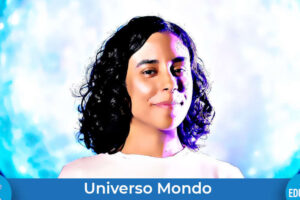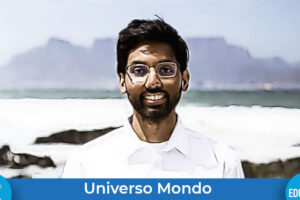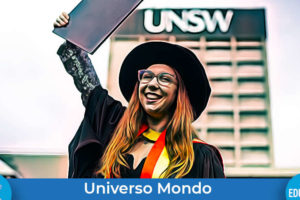Aggiornato il 28 Novembre 2024

This month, our column visits the Netherlands, a small country with a strong astronomical community, with an interview to Marieke Baan, Head of Communication at the Netherlands Research School for Astronomy. Through her expertise as a journalist and science communicator, we explore the Dutch efforts to bring the Universe to the media and into society, along with major stereotypes and current challenges in the field of science communication, both nationally and globally.
Welcome to Universe World, Marieke. Could you introduce yourself, your current role and the path that brought you there?
I was a journalist for the Dutch broadcasting organization NOS before I crossed over to the “˜dark side’, as some call science communication. I studied social and political sciences, with a major in mass communication and minors in international (space) law and mass psychology.
I left the NOS after 12 years because, as an editor-in-chief of the fast-growing online department, I started to miss the journalistic craft. After one year as a freelance journalist, in 2005 I decided to apply for the position I now have at NOVA, the collaboration of the Dutch university astronomy institutes. They were looking for someone with journalistic skills, a good network in media and “˜affinity’ with astronomy. So, right vacancy at the right moment.
As a journalist, how did your “˜landing’ among astronomers go?
Very well, actually. I was a bit surprised they hired me because I don’t have a background in astronomy. After high school I never did anything with physics again. But I ended up “˜in a warm bath’ as the Dutch expression goes. I was given the space to attend first-year lectures, there was a committee with representatives from the four institutes, which advised on strategic issues, and also helped to quickly build a network within Dutch astronomy. I’m still grateful for their support. Some astronomers were a bit sceptical at first but by talking about my own background and the ideas I had for astronomy communication, that turned around quickly.

What are, in your opinion, the main stereotypes and misconceptions that scientists have towards journalists?
The main misconception that scientists have about journalists, is the idea that you can determine to a large extent what a journalist produces in the end, whether it is a TV item or a newspaper article. Of course, you can ask for a fact check before publication, but you can’t edit the piece. Journalists are free to do [what they wish] with the information you give them. Of course, there are tricks and tips to make sure they tell the story you want to tell them. Sometimes journalists also have an interest other than yours. If you are aware of that, you already start an interview better prepared. Things like that are covered in the media training we organize for scientists at different stages of their careers.
A second misconception is that astronomers sometimes can’t believe their result is not interesting enough for media to cover. This has to do with the fact that the world of media cannot be compared to the world of science. In the latter, hard facts and discoveries are leading, in the media it is also about, for instance, the daily news feed, the day of the week (never send a press release on election day or on a Friday), whether something has been covered before and many other journalistic considerations and guidelines. You can also clarify this well in media trainings.
And the other way around?
The main misconception of journalists towards scientists is overrating the scientist. Even science journalists tend to often ask the same people to comment on a piece of scientific news. But in many cases, this scientist is not a specialist in the specific field at all. Their piece could be much more interesting with the comment of an expert.
Could you describe the astronomy community in the Netherlands: is it a large community, how is it organized, what are the leading topics and projects?
Astronomy in the Netherlands is not that big, compared for instance to physics or chemistry, but it is one of the most visible disciplines in the news, in public engagement and on social media. NOVA represents the four institutes at the Universities of Amsterdam, Groningen, Leiden, and Nijmegen. For radio astronomy and space science two separate institutes exist ““ ASTRON and SRON, directly funded by the national science organization NWO. The national society is called Royal Netherlands Astronomy Society (KNA). The amateur community is organized within The Royal Netherlands Association for Meteorology and Astronomy. The Dutch astronomers work together within NOVA on the big scientific topics, on instrumentation, educating excellent PhD students, and in communicating astronomy at the (inter)national level (through the NOVA Information Center).

How do you coordinate astronomy communication nationally?
All institutes have their outreach staff (often part-time or volunteering) for open days, stargazing nights and other local public engagement or school projects. Often professional astronomers are also engaged. The press communication, public engagement, and education (for schools) at the (inter)national level is coordinated by NOVA.
Do you have many collaborators?
When I started at the NOVA Information Center (NIC) in 2005, I was the only staff, for science press work and online (web, social media) only. Over the years, we managed to expand the NIC to include a press officer, an education coordinator, and a planetarium programmer. Our largest educational project (four mobile planetariums) involves 25 students to deliver the lessons/shows at schools. Some are also involved in the logistics. We also work closely with the outreach staff at the institutes, SRON and ASTRON.
Is the Dutch public curious about science? And astronomy in particular?
As in every country, astronomy is also popular in the Netherlands. Not only among the general public but also among journalists. The Leiden Science Communication and Society group examined the portrayal of physics in five major Dutch newspapers in 2018 and 2019. Results show that astronomy and astrophysics is the most prominent field with 44% of the articles. It would be interesting to find out what the impact of the astronomy communication work is. There is to my knowledge no research on the effect of science press communication in a certain field on media representation. If I ever get a PhD, I want to do it on this topic!

How do you raise the interest towards an exotic topic such as astronomy?
In general people get excited by beautiful things, like stunning pictures of the Universe, and by more or less incomprehensible and exotic things like black holes and gravitational waves. It is, of course, the Hubble Space Telescope that brought astronomy into the living rooms ““ I don’t remember whose quote this is, but it certainly is true.
Any special “tricks” you use in your communication activities to engage different audiences?
Journalists like to publish about astronomy, especially when it comes with beautiful images. In a small country like ours, it is easy to build and maintain a media network. We all know each other, and the line between science journalism and the so-called dark side (press communication) is much thinner than often perceived. If you use journalistic values in your science communication and operate from journalistic principles, the relationship with science journalists can be very rewarding.
It certainly helps that within NOVA we have a strict separation between science communication and other communication activities people conduct at universities like student recruitment, public relations, and marketing. These activities are also part of communication departments but have a totally different message-medium-audience approach, and different goals than science press communication and public engagement.
This reminds me of your recent contribution at the European Astronomical Society 2023 annual meeting titled: Stop reinventing science communication! (Please don’t, but also invest in building structures). What do you mean by “˜reinventing science communication’ and what should we do instead?
Science communication is blooming for the last ten years or so. Universities and institutes invest in communication. New initiatives pop up everywhere, always with the best intentions, but often without awareness of existing projects and sometimes even without any knowledge of science communication research and practice. A study in the UK showed that the traditional science press communicators are often overlooked and that communication departments focus more and more on marketing.
In my opinion, the work of the science press officers should be regarded as the basics: they have the best overview of their field, are very well informed, know where the interesting stuff happens, have their internal and external networks in place, can write clear texts, know how to communicate, and engage with the public, et cetera. So, I would advise to connect all new initiatives – when feasible – to existing ones and build science communication groups. It’s more efficient, more effective, and more sustainable.

This is a very relevant point you raise, especially in the constantly changing digital media ecosystem nowadays. Also with reference to these new trends, what do you think are the main challenges in science communication today, in your country and also globally?
I think the main challenge is that universities and institutes take science communication more seriously, add it to their communication mission and strategy, and connect new initiatives to existing ones. Secondly: scientists with an affinity with, and good ideas for communication should be given enough space, not on their own, but in collaboration with the professional communicators. A third challenge might be the quality over quantity discussion. More is not always better. It’s important to evaluate the impact of your science communication and adapt your strategy when necessary. When you have a good mission, strategy, and “˜structure’, this is much easier than when projects and initiatives are fragmented.
We talked about misconceptions between scientists and journalists earlier, but do you feel there are misconceptions also about practitioners and scholars in science communication?
Science communication is a profession, and the science of science communication an academic field, not something you do “˜on the side’. Science communication is so much more than giving a talk at the school of your child. It’s a message I repeat often because astronomers are as stubborn as any other scientists.
Tell us about a big project you communicated and what contributed to make it a success…
Can’t choose between the International Year of Astronomy 2009, the first LIGO/Virgo detection of gravitational waves in 2015/2016, the IAU centennial (IAU100) in 2019, including the NameExoWorlds campaign, and the JWST Early Release Observations in 2022. If you look at public engagement IAU100 was a huge success, partly because of the NameExoWorlds campaign: 16.000 people proposed names for the “˜Dutch’ exoplanet and star, after a huge media campaign with dozens of articles and interviews on TV. Twitter was in 2019 still a perfect medium to amplify. Within the NOVA Information Center we combine different skills, and that also contributes to the success of big projects. Right at the start of a big project, the team develops an integrated plan for the press campaign, multimedia, social media, exhibitions, and public engagement activities.
Would you like to tell us more about any other of your ongoing projects?
In 2010 we started with a mobile planetarium school project. In the meantime, we expanded from one to four domes and reached almost half a million school children to date. We went through the data we collected since the start, and we found out we miss some target groups: schools in the underserved areas of big cities, and schools in the most rural areas. With some seed funding we are doing some extra research, and we applied for a grant to make a first step towards a more inclusive and diverse project. On the news side we are also working on an expansion of our activities towards underreached target groups. We are specifically looking at new communication tools and channels to, for instance, better engage with young people.

What are the most exciting and most difficult parts in your job?
Most exciting: you are on top of astronomy news, sometimes already months in advance. Exciting to make a communication plan with the astronomers involved, organize press events, public events and developing the materials. Most difficult: working within the huge global collaborations that today often adopt a centralised communication strategy. These often do not take into account national customs and needs when it comes to embargoes, for example. That can be very frustrating.
Are there any authors, books, notable people or special events that influenced you along your journey?
As a kid, I was interested at the exotic part of the world and the Universe, mainly volcanoes and black holes. The latter because the popular science magazine to which my brothers and I subscribed paid a lot of attention to it. When my own children were small, we lived next door to the Utrecht Observatory. At that time, my renewed interest in the universe began. In my current position many people inspired me: Ewine van Dishoeck, Gijs Nelemans, Amina Helmi, Henny Lamers, Alex de Koter, Ignas Snellen, Vincent Icke and Paul Groot, to mention a few. All astronomers with a big heart for science communication and excellent sparring partners.




Add Comment